Clouds Heading in New Directions
Clouds Heading in New Directions

IDG Connect, a division of International Data Group (IDG), the world’s largest technology media company, produces, publishes and distributes local IT and business information on behalf of a truly global client base. Established in 2005, we have a fully nurtured audience of 2.6 million professional decision-makers from 130 countries, and an extended reach of 38 million names. This lets us conduct research, create independent analysis and opinion articles, and drive long-term engagement between professionals and B2B marketers worldwide.
For more information visit:
www.idgconnectmarketers.com

Barriers to Cloud Adoption
Just over a third of organisations in the countries surveyed are happy with the security delivered by public cloud providers. Yet the majority (62%) are dictated by strict data protection requirements which demand that data and applications are hosted within private, on-premise clouds.premise hosting.

Hybrid Cloud Benefits
The benefits associated with hybrid cloud are widely recognised. Over three quarters rate the ability to accommodate performance, availability and reliability requirements and provide greater resource control as advantages alongside service cost optimisation through greater use of public clouds.

Open Source Cloud Platforms
Ease of use for staff configuring and provisioning cloud services are also valued highly by large numbers of organisations, as is the ability to integrate cloud virtualisation platforms with other systems in on- and off-premise hosting.
Asia is judged a hot bed of demand for cloud services due to the nature of its emerging economies. Local markets see a high complement of start-ups and smaller businesses, both of which are unencumbered by legacy in-house IT architecture. These firms are also naturally inclined to opt for on-demand cloud usage models which minimise spending capital expenditure and shifting equipment costs into monthly service fees.
Some territories, including China, Indonesia and Singapore have also seen strong support for cloud transition initiatives from central government coupled with a high level of investment in cloud hosting data centre facilities from global multinationals such as IBM, HP, Google and Microsoft.
That public and private sector backing is clearly paying dividends. Spending on public cloud services alone in the mature Asia Pacific (excluding Japan) market is expected to rise from $7.4bn in 2015 to $11.5bn by 2018, according to research company Gartner*.
Driving part of that expansion will be a wholesale migration to what IDC terms ‘The Third Platform’ – cloud, analytics, mobility and social business (dubbed the SMAC stack). This is expected to push a growing volume of virtualised applications and services into a broad mix of public, private and hybrid cloud platforms in parallel with steady improvement in the capacity and reliability of telecommunications networks and broadband service provision**.
IDG Connect interviewed 232 decision makers based in Asia and Australia to quantify their current use of different cloud computing platforms.
The survey gauged their appetite for moving more applications and services into cloud hosted environments over the next two years and assessed attitudes to open source cloud/virtualisation platforms such as OpenStack. It also gathered opinion on whether closer integration of local and remote hosted systems management, orchestration and virtualisation tools could deliver operational advantage for cloud hosted service provision.
Those taking part were equally split across Australia, China, Hong Kong, India, Indonesia, Japan, Korea, Malaysia and Singapore. The majority (59%) worked for organisations employing between 100 and 1,000 people, with 32 percent reporting staff headcounts of between 1,000 and 10,000 and 9 percent over 10,000.
All of the respondents IDG Connect polled hold senior roles within their companies. Many (43%) work either as IT managers or IT directors, with 30 percent employed in board level roles such as chief information officer (CIO), chief technology officer (CTO) and chief security officer (CSO).
A broad range of industry verticals are represented, with 12 percent of respondents working in the financial sector, 11 percent engineering, and 10 percent manufacturing.
* ‘Forecast: Public Cloud Services Worldwide 2012-2018’, Gartner, 2015
** ‘IDC FutureScape: Worldwide IT Industry 2016 Predictions – Leading Digital Transformation to Scale APEJ Implications’, IDC, 2015
The research found that organisations across Asia and Australia today rely on a mixture of different cloud platforms and will continue to do so in the future despite subtle changes in usage patterns across all nine countries being expected.
Over half (58%) on aggregate currently use off-premise, public cloud services, leased and provisioned with approval of the resident IT department (examples include those delivered by Amazon Web Services, Google, IBM, HPE and Microsoft) and this is unlikely to change between now and 2018.
Around a third will also continue to use off-premise, public cloud services which have not been approved by their organisation. This may present the resident IT department with something of a headache when it comes to tracking and monitoring usage, and controlling the costs associated with those services.
A similar number of the organisations surveyed also rely on off-premise, private cloud solutions which are hosted in third party data centres on dedicated, single tenanted servers to ensure greater levels of security, performance and availability compared to public cloud services. That too is unlikely to change in the future, with 32 percent relying on this type of cloud platform today, and 30 percent expecting to do so in 2018. The research does predict a shift in cloud service usage when it comes to on-premise private cloud and hybrid cloud solutions.
Fewer organisations in Asia and Australia (39%) expect to use on-premise, single tenanted private cloud platforms in 2018 compared to the 46 percent that do today.
As usage of on-premise private clouds falls slightly, organisations will come to rely more on hybrid clouds that mix different elements of on- and off-premise private clouds and public clouds within a single platform or service. This number will grow from just over a quarter today (27%) to 41 percent in two years’ time.
This transition provides a strong indication that in many cases it is more of the virtualised applications and workloads which currently reside in on-premise private clouds specifically which will be incorporated into hybrid clouds in the future.
The findings mirror those found in the RightScale 2015 State of the Cloud Report published in February 2015* which found hybrid cloud to be the preferred strategy for many enterprises going forward. Most (82%) of the 930 IT decision makers the report surveyed in all regions of the world had a hybrid cloud strategy in place at their organisation, up from 74 percent 12 months previously. And 55 percent had already had a hybrid cloud in place, up from 48 percent in 2014.

It is important to note that static or declining use of on-premise private cloud solutions as organisations move more workloads onto hybrid platforms may not tell the whole story. The volume of the virtualised applications and services kept in on-premise private clouds could actually be higher. The RightScale report found that 13 percent of enterprises ran more than 1,000 virtual machines in public clouds in 2014 for example, but more - 22 percent - ran the same number in some form of private cloud.
Nor does the suggestion that the use of on-premise private cloud solutions will fall necessarily mean that existing private cloud platforms will be scrapped. In many cases they will be integrated in hybrid cloud platforms that span both private and public cloud architecture as long as they can be effectively combined using suitable hybrid cloud management systems.
Further evidence for this trend comes from the Forrester Global Business Technographics Infrastructure Survey**, which surveyed 3,592 global respondents last year. It found that 65 percent of organisations were using more than one public or private cloud platform simultaneously, indicating that hybrid clouds were already a reality though not necessarily combined into a single entity using effective hybrid cloud management platforms.
Regional preferences for different types of cloud platform are also in evidence within Asia and Australia. IDG Connect’s research shows that organisations in two countries – Japan and Korea – show markedly higher preferences for both approved and unapproved public cloud services than their colleagues elsewhere.
Those in Australia and Singapore make more use of on-premise, private clouds currently, but that usage is set to fall in Australia whilst remaining static in Singapore. Companies in India specifically expect to see the most significant growth in their use of hybrid clouds, anticipated to rise from 28 percent today to 69 percent in 2018.
* ‘2015 State of the Cloud Report’, RightScale, February 2015
** ‘Global Business Technographics Infrastructure Survey’, Forrester, August 2015

Security remains the most important objective for organisations implementing any type of public, private or hybrid cloud solution. Most, if not all, IT departments remain keen to ensure the safety and integrity of data stored in both on- and off-premise cloud application and service hosting environments.
Different countries attribute varying levels of priority to security and governance however. The IDG Connect findings suggest respondents in Indonesia (25), Australia (24) and Singapore (24) rate this as a slightly more important objective than their colleagues in the other territories surveyed.
Nor is improving security and governance the only aim for cloud implementations: other ambitions are apparent and ascribed roughly equal levels of importance.
Being able to quickly self-provision automated cloud resources to support the rapid development of innovative new products and services is vital for many. This indicates a firm focus on platform as a service (PaaS) resources which can be quickly and easily aligned with application development, testing and quality assurance (QA) activity.
It also suggests that those application developers and development operations (DevOps) staff do not want any overhead or delay in requesting the infrastructure resources they need when they need them. These job functions may therefore welcome cloud service management platforms which allow them to provision those PaaS resources automatically and directly without involving the IT department or distracting them from their core application and service development activity.
The ability to scale IT capacity up or down to meet fluctuating or temporary business requirements – typically server, CPU and RAM resources packaged within infrastructure as a service (IaaS) workloads - is rated almost as highly. The same is true for cost transparency in being able to accurately predict the fees associated with individual IT projects and services for budget forecasting and departmental chargeback purposes.
Organisations consider access to cloud platforms from multiple client devices (including laptops, smartphones and tablets for example) as equally important. This suggests that many of the organisations polled are catering for a mobile workforce that needs to stay connected to centralised applications and services from wherever they happen to be, irrespective of the device they are using.

There is strong evidence to suggest that there is significant headroom for more enterprise workloads to be moved into the cloud. RightScale* estimates that 68 percent of organisations globally currently run less than 20 percent of their applications on some form of cloud platform. Just over half (55%) of the IT decision makers RightScale surveyed reported that a significant portion of their employers’ application portfolio was not hosted in the cloud despite them being cloud ready.
There still appear to be major barriers which may be preventing organisations in Asia and Australia from moving more of those workloads into the cloud. In addition to being an objective for their cloud implementations, we see that providing adequate data security and complying with any government or industry data protection regulation is also their biggest source of apprehension.
Almost three quarters (73%) of those surveyed by IDG Connect consider concerns about security and data protection as a barrier to their organisation adopting or expanding its use of cloud computing. This reflects extant fears that some cloud platforms cannot be trusted with sensitive, mission-critical information, subject to national or international data protection laws.
That distrust is more accentuated when it comes to public, rather than private cloud services. Only 37 percent of organisations on aggregate reported themselves happy with the level of protection delivered by public cloud providers. The majority (63%) indicated the prominence of strict security requirements within their organisation which demand that data and applications are hosted within private, on-premise clouds.
Lack of control over cloud hosted data,
applications and services is the second most widely perceived obstacle to cloud migration. Almost the same number of organisations (62%) believe the complexity associated with integrating their existing on-premise IT infrastructure with cloud platforms will stop them from making the move. This is a firm indication that many of the organisations polled currently, and will continue to, use multiple on- and off-premise public and private cloud services that will need to be supported by effective hybrid cloud management solutions if those doubts are to be addressed.
Roughly one in two organisations across all nine countries surveyed by IDG Connect doubt they will be able to negotiate customised service level agreements (SLAs) with single or multiple cloud service providers to match their specific business requirements.
Half worry about being locked into specific vendor or technology platforms which may limit their choice when it comes to upgrading existing application and service platforms, or migrating to new ones. The same threat may also hamper their ability to shift individual virtual machines and workloads between multiple on- and off-premise cloud services.
Again, the research points to regional variations of opinion. Slightly more of those based in Australia (79%) and Singapore (74%) see security and data protection concerns as a barrier to cloud migration, but the number is even higher for respondents working for companies in Indonesia (85%) and Malaysia (96%).
* ‘2015 State of the Cloud Report’, RightScale, February 2015
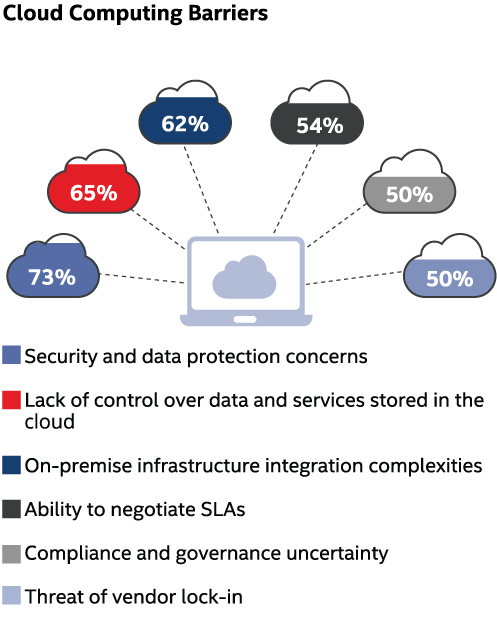
The anticipated shift to hybrid cloud deployments that span both on- and off-premise private and public cloud service platforms brings its own challenges, many of which are identified in the Infographic Summary.
Those taking part in the IDG Connect survey appreciate that greater integration of virtualisation platforms and systems management and orchestration tools can go some way to addressing those concerns, however.
Just over a quarter felt this was a strategy which could enhance their current data security and compliance operations by helping control and manage governance policies. For example, this includes tighter integration and improved security controls by streamlining identity verification processes and resource access permissions.
Almost as many of those polled felt that integrating virtualisation, systems management and orchestration tools more closely could also speed up IT service and application provisioning.
A recent report from Forrester* echoes these findings. It found that fast provisioning features are able to deliver basic resources in less than 15 minutes, and more complicated virtual workload templates in less than an hour, to be a highly valued element of private cloud solutions, albeit one that required automated tooling to ensure this could be achieved. Tighter systems integration was also considered a conduit to providing greater visibility into active workloads. Combining infrastructure, platform and application layers across public, private and hybrid cloud platforms could potentially improve end to end service and infrastructure deployment, migration and monitoring capabilities.
By delivering all three advantages, that integration could then provide a foundation for more applications and services currently hosted in legacy infrastructure to be moved into cloud orientated platforms in the future.
Organisations currently use a broad mix of virtualisation and systems management tools as the basis for their private cloud platforms, but the level of integration they support between each other and public cloud platforms varies considerably. RightScale** identified VMware’s vSphere/vCenter as the most widely used private cloud platform in 2015, ahead of VMware’s Cloud Suite, OpenStack, Microsoft System Center, Citrix CloudStack and Microsoft Azure Pack. However, use of both OpenStack and Microsoft Azure Pack was expected to increase at a faster rate than any other platform in the future.
* ‘The Forrester Wave: Private Cloud Software Suites’, Forrester, March 2016
** ‘2015 State of the Cloud Report’, RightScale, February 2015
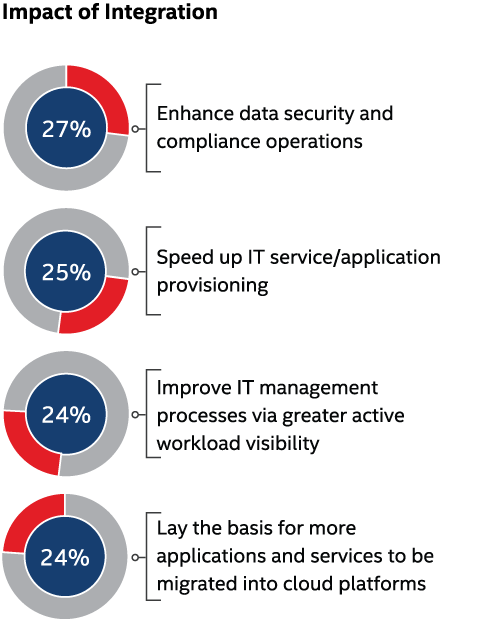
Better data security and compliance provision is widely seen as a benefit associated with private cloud implementations that run applications and services either within the organisation’s own on-premise data centre, or in dedicated, single tenanted server and storage platforms hosted remotely within third party facilities.
Over two thirds (69 percent) of the organisations polled by IDG Connect also consider this type of cloud architecture well placed to accommodate specific application and/or service performance, availability and reliability requirements. This could in part be due to a perception that localised workloads - or those protected by virtual private network (VPNs) and service level agreement (SLA) guarantees - are less likely to be disrupted by wide area network (WAN) latency or downtime issues.
The same number (69%) also believe private clouds can help provide greater control of hosted resources. This typically depends on either keeping them on-premise or providing better management tools, such as provisioning, management and monitoring portals, to applications and services hosted off-premise.
Other evidence also points to a desire for control which extends beyond tight supervision of cloud hosted applications, services and IT capacity. Being able to control how end users themselves access those resources was also identified as a key element of private cloud platforms by Forrester**.
It concluded that what infrastructure and operations (I&O) professionals want is granular permissions to manage how individual staff and business departments request service options, set quotas and limits for every group
and user, track usage, and allocate costs for billing and chargeback purposes.
Forrester* also found enterprise interest in private cloud deployments to be consistent. It estimated that 67 percent of organisations consider building private clouds to be a high priority, and 43 percent had adopted them already (up from 38 percent a year earlier). Almost a quarter of those built their private clouds using either a series of private cloud software solutions or commercial private cloud software, with 13 percent favouring converged hardware/software solutions and 12 percent open source platforms.
The IDG Connect survey found that when based on a single, rather than multi-vendor, infrastructure platform, private clouds are also thought to simplify support, management, maintenance and configuration requirements.
This can be achieved by removing the need to install, set-up and monitor different brands and types of underlying hardware and software by standardising on a single platform, thereby removing potential compatibility and interoperability problems.
In its report, ’Preparing for Private and Hybrid IT with Red Hat Cloud Infrastructure’ published in February 2015, research company IDC noted that any migration to private or hybrid cloud infrastructure would require changes across the entire stack. That stack spans middleware and applications as well as data centre and IT operations, reinforcing the idea that greater integration between existing virtualisation, systems management and orchestration tools is required.
But IDC also concluded that many organisations would continue to use legacy infrastructure and applications for some time
to come, meaning an evolution of existing assets alongside pockets of newly created cloud resources is necessary. IDG Connect’s findings reinforce this theory, with just over half of those polled (53%) associating the ability to take the strain off legacy, in-house infrastructure as a benefit of private cloud.
*‘The Forrester Wave: Private Cloud Software Suites’, Forrester, March 2016.
**’Preparing for Private and Hybrid IT with Red Hat Cloud Infrastructure’, IDC, February 2015

The benefits of private clouds are also strongly associated with hybrid clouds that run some applications and services in private on-premise clouds, and others in public clouds.
This is logical given that the latter utilises elements of those same private cloud platforms to a certain extent.
We see that 75 percent of respondents surveyed by IDG Connect in Asia and Australia consider the alleviation of data security and compliance concerns as a significant or major benefit of hybrid clouds.
Slightly more on aggregate (79%) saw the ability to accommodate specific application and service requirements around performance, availability and reliability requirements as an advantage, again alongside greater control over available cloud hosted resources.
There is a strong suggestion that hybrid clouds are also more likely to be seen as a safe, gradual step to other forms of cloud migration.
This again represents a logical progression as they pave the way for greater, or more efficient, utilisation of both private and public cloud services which span on- and off-premise environments.
Over three quarters of those taking part in the survey indicated that they believe hybrid cloud implementations can optimise IT delivery costs by shifting non-mission-critical applications and workloads into public clouds which may be cheaper to lease compared to the cost of running them within on-premise architecture. Many (69%) also feel that hybrid clouds can help alleviate any strain on in-house infrastructure struggling to support demand for current and future application and service workloads.
Despite their comparatively low use of hybrid clouds today, or intentions to migrate to hybrid cloud platforms in the future, more organisations in Japan and Korea rate the advantages of hybrid clouds greater than in any other territory.
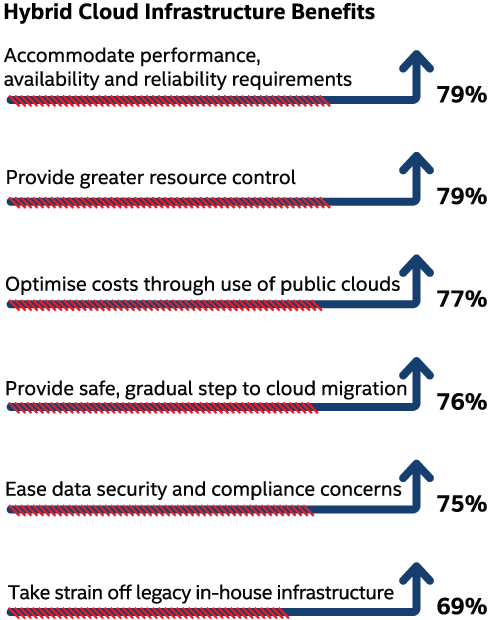
While the benefits of hybrid clouds are widely recognised, respondents also identify major barriers which they feel may prevent their organisations from implementing this type of cloud platform.
Chief amongst these is the initial cost of integrating legacy on-premise infrastructure and applications and/or private clouds with off-premise private or public cloud architecture. Many (28%) of those polled also think that integration will lead to greater service and application management overheads with both cost and staff resource implications of their own. The same number (28%) are wary of having to negotiate multiple SLAs with different cloud service providers should those hybrid platforms be used to combine privately hosted clouds with public cloud services such as those provided by AWS, Google, IBM (Softlayer), Microsoft, and others.
These three findings combined provide a strong indication that some commercially available hybrid cloud management systems are seen as overly expensive to purchase, install, manage and maintain. It is also perceived that they are likely to involve extra work for existing staff trusted with their administration.
Nor do many respondents judge that the different technology elements and cloud platforms which typically underpin hybrid architectures are always interoperable. This lack of compatibility could have a number of potential consequences, not least of which is additional configuration, management and maintenance headaches.
It may also prevent applications and services from being moved seamlessly between on- and off-premise environments to meet business requirements and limit the
organisation’s ability to switch cloud providers to optimise costs where required.
The perceived barriers to cloud adoption are not limited solely to the practical. A quarter of those surveyed on aggregate felt that the absence of in-house skills in hybrid cloud operations and management could prove insurmountable, and a similar number doubt support for hybrid cloud deployment initiatives at management or boardroom level (barriers felt more keenly by organisations in Japan and Korea specifically).
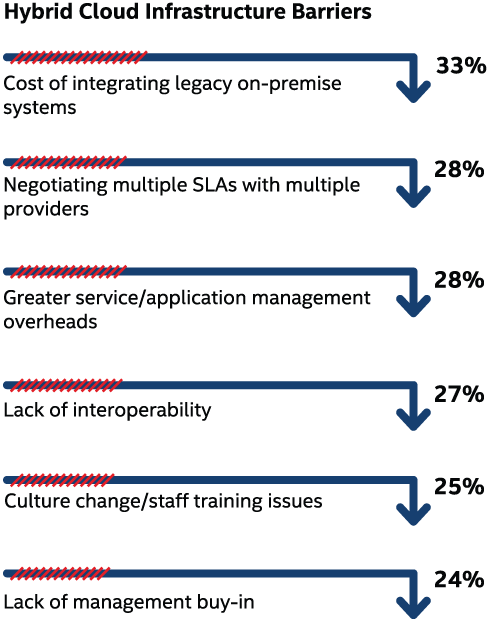
OpenStack is an established open source software platform which is used as the foundation for many different private, public and hybrid cloud computing services. It is therefore no surprise to find that OpenStack has been widely implemented by organisations across all nine countries surveyed by IDG Connect. Only two percent of those polled on aggregate do not use OpenStack at all, and that number increases only slightly to eight percent in Hong Kong and Malaysia specifically.
OpenStack is used as the basis for almost all types of cloud services - including on- and off-premise private, off-premise public and hybrid clouds - in roughly one out of every two organisations within the region. It also underpins a diverse range of virtualised workloads and services, most notably infrastructure as a service (IaaS) applications in 57 percent of cases and database as a service propositions in 56 percent.
Scheduled backup and disaster recovery operations run on OpenStack in just over half of all organisations (53%).
Platform as a service (PaaS) projects use OpenStack as the underlying virtualisation platform in 48 percent of organisations, alongside analytics as a service application (46%), desktop as a service and/or virtual desktop infrastructure (VDI) platforms (43%) and seasonal web applications or temporary online hosting requirements (40%). Indeed, those OpenStack supported workloads tally quite closely with four specific applications that organisations in Asia and Australia consider almost equally important when it comes to provisioning temporary IT capacity, irrespective of whether they actually use OpenStack or not.
These are namely additional CPU/RAM/Storage to support business expansion (IaaS);
scheduled backup and disaster recovery operations; planned ad hoc testing and development projects (PaaS); seasonal web applications and online hosting demands. These findings also indicate that OpenStack is regularly used to support workloads which are widely deemed as mission-critical.
Forrester* evaluated 11 commercial hybrid cloud management platforms, some of which – including those from CliQr Technologies, Dell, IBM, Red Hat, RightScale and Scalr - use OpenStack as their foundation. The same is true for private cloud platforms, with Forrester also highlighting OpenStack based applications from HPE, IBM and Red Hat as leaders alongside non-OpenStack alternatives from VMware.
*‘The Forrester Wave: Hybrid Cloud Management Solutions’ Forrester, March 2016
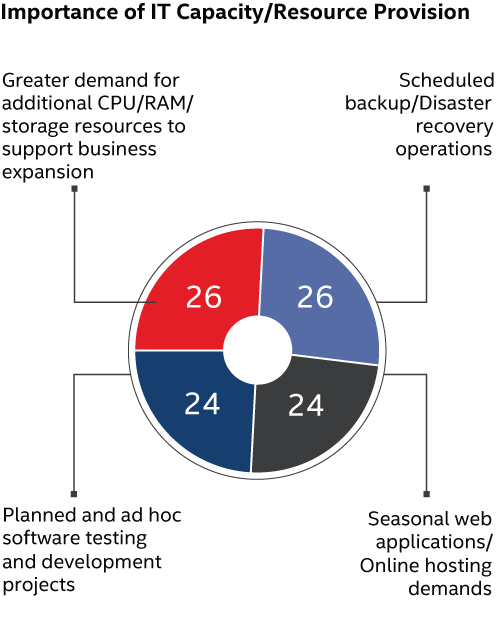
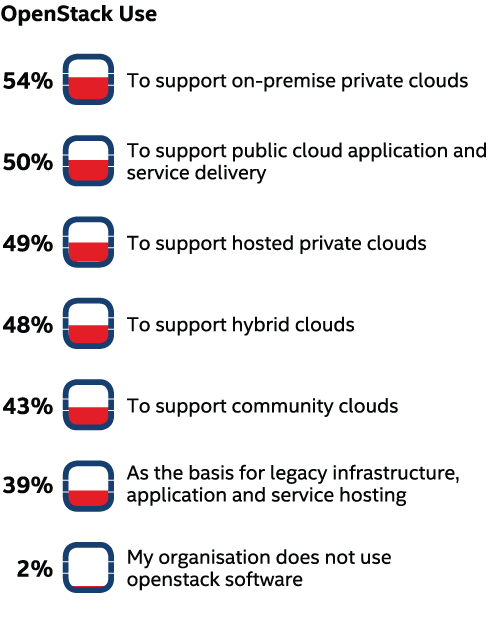
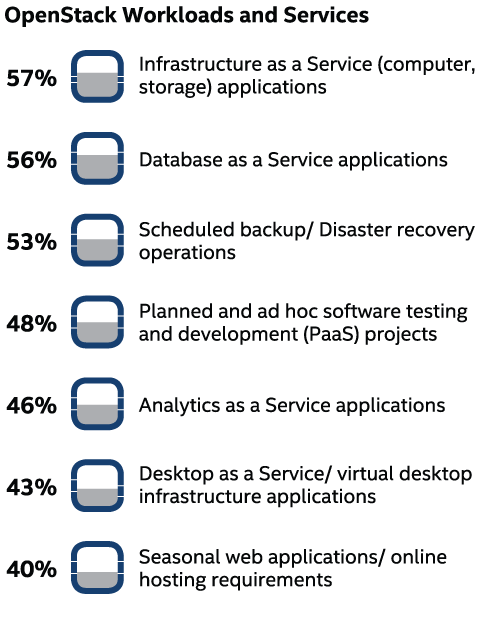
With so many organisations in Asia and Australia already using OpenStack clouds, they are well placed to judge the benefits that open source cloud/virtualisation platforms deliver.
For example, over two thirds (69%) consider strong interoperability and application programming interfaces (APIs) to be one advantage. This again mirrors Forrester’s findings*, which concluded that the use of fully published representational state transfer (REST) based APIs that link to public cloud platforms offer significant advantages alongside element management and monitoring tools.
Those advantages include improved productivity for in-house developers compared to working through web graphical user interfaces (GUIs), allowing the administration team to build out integrations not already available from the cloud providers in question.
They also provide the ability to swap out certain portal functions for alternative market solutions such as application and service configuration management tools.
Many (59%) of those surveyed by IDG Connect additionally identified adherence to open standards that minimise the risk of vendor lock-in as a positive attribute of open source cloud/virtualisation platforms. In other words, they value the ability to change those cloud platforms when it suits them and move virtualised workloads around between different cloud services to match business requirements.
Other perceived benefits include access to the underlying source code and access to a broad software developer and vendor ecosystem. This indicates that many are actively looking to customise the cloud/virtualisation platforms they deploy using the help of internal or
external developers and third party software companies.
Cost is again a consideration. Over half (56%) rated a billing model that shifts expenditure away from software license fees and into annual support and maintenance charges as important. Roughly the same number (58%) also saw low software acquisition costs as a positive trait, one that holds a strong attraction for a significant percentage (14%), citing this as the single most important benefit of all.
*‘Forrester Wave: Private Cloud Software Suites’, Forrester, March 2016 report
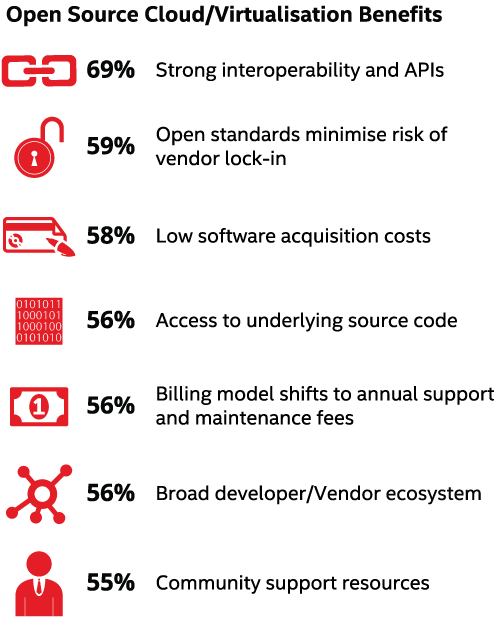
The two attributes that most organisations in Asia and Australia value in open source cloud virtualisation platforms based on software tools such as OpenStack are stability and performance.
Clearly, their top priority is to make sure that the cloud hosted applications and services they deliver to end users are always available and remain unhampered by latency, slow access speeds, infrastructure downtime or other issues.
Ease of use for IT staff configuring and operating those virtualisation platforms is also highly rated by 70 percent. This suggests they would prefer to minimise the overhead involved in managing cloud hosted applications and services wherever possible, and would welcome cloud management platforms which provide automated provisioning, allocation and migration controls.
The need to combine multiple public and private cloud services under a single hybrid platform is again in evidence. Integration with other on- or off-premise hardware and software systems in use was cited as a benefit by 68 percent of those polled.
A good number (59%) also rated the distribution of regular software upgrades and planned release cycles as an advantage. These are features that match commercial software applications, but which could also make it easier for companies to deploy and manage cloud platforms themselves without external assistance.
Just over half (53%) see interoperability as an important element. However, it is undoubtedly more of a priority for the 11 percent who identified it as the single most critical attribute of open source cloud/virtualisation platforms.
This may suggest equal numbers of organisations would prefer to run open source cloud and virtualisation platforms as a pervasive architectural solution - and perhaps as a single vendor system - and do not intend it to be integrated, or to communicate, with other platforms within their chosen cloud service delivery environments.
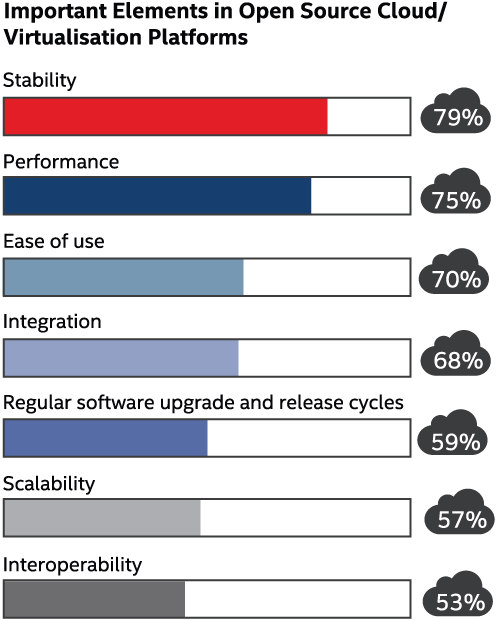
The results of the IDG Connect survey demonstrate that organisations across Asia and Australia currently rely on multiple different cloud platforms for IT service delivery and will continue to do so in the future. Yet the next two years will see more integration of private and public cloud services into hybrid environments which span both.
Improving security and governance is the top priority for those cloud implementations as data protection concerns continue to dominate. Both private and hybrid cloud implementations are considered well placed to address those data security and compliance concerns. Other advantages are widely recognised. Having greater control of the data and applications stored in cloud environments is seen as a particular asset alongside the ability to meet specific application and service workload performance, availability and reliability requirements.
However, there are caveats despite their broad appreciation of the benefits hybrid clouds can offer, organisations in Asia and Australia remain wary of the costs involved in integrating legacy on-premise systems with on- and off-premise cloud environments. This is an architectural approach which they also feel will lead to increased management overheads.
Some of those concerns could be addressed through cloud service management platforms that automate application and service provisioning, migration and monitoring. Combining multiple public and private cloud services and their associated service level agreements (SLAs) from different providers within a single platform or service package may also help to allay lingering doubts. Indeed, many companies across the region felt that tighter links between on- and off- premise cloud virtualisation, systems management and orchestration tools could help them enhance
their existing security frameworks and aid compliance with corporate, government and industry regulation.
The OpenStack software platform is already widely used as the basis for public, private and hybrid cloud implementations, supporting a variety of IaaS, PaaS, DaaS and backup and disaster recovery workloads. As an open source platform, access to the underlying source code, low software acquisition costs and a billing model that shifts fees into annual support and maintenance charges were identified as benefits by more than half of the organisations taking part in the IDG Connect survey. But the big convenience of open source cloud/virtualisation platforms is seen as strong interoperability and APIs which allow in-house developers to build their own links to public clouds and utilise third party solutions for application and service configuration.
Whether they are based on OpenStack or something else, the stability and performance of those open source platforms cannot be compromised. It is deemed critical by over three quarters of all of those polled.
With hybrid cloud usage set to increase, organisations in Asia and Australia must now carefully assess the underlying hardware and software requirements they will need to build efficient, reliable cloud environments which are flexible and easy to manage. In doing so, they must match their individual business and performance requirements against the full range of proprietary and open source options available from every vendor if they are to avoid making expensive mistakes.

